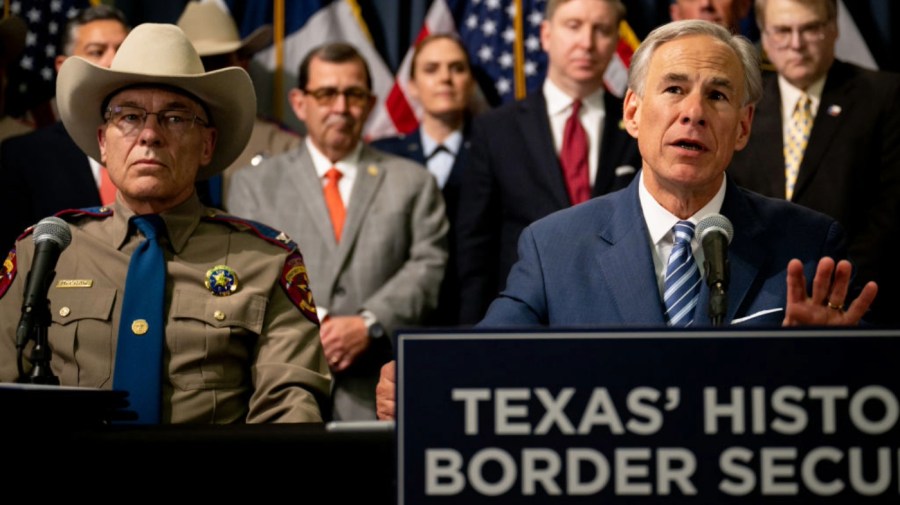
Texas Gov. Greg Abbott (R) is relying on the compact theory of the U.S. Constitution to defy the U.S. Supreme Court, urging that Texas is an independent sovereign state in compact with other states and can ignore, the term usually used is “nullify,” federal law in Texas. Seeing political advantage some other Republican governors have thrown Abbott their support.
Abbott’s argument has no support in the history or text of the Constitution and is dangerous.
The compact theory was familiar to Americans in the 1780s because the failed Articles of Confederation were a compact of sovereign states. Of course, that is why the articles failed: The government didn’t work. The national government was controlled by the states. The United States was unable to function properly, even to pay its debts. Revolutionary War soldiers went unpaid. We were an international laughingstock.
That is why the Constitution was adopted.
After the Constitution was ratified, no one seriously argued that it was a mere compact. For example, Patrick Henry argued that Alexander Hamilton’s plan for federal assumption of state debts was unconstitutional, but no one suggested that the Constitution was a compact and that Virginia could ignore, or “nullify,” federal law and refuse the federal takeover of its debt.
Founders protested the National Bank, the Jay Treaty, the Whiskey Tax and the Carriage Tax but no one argued that the Constitution was a mere compact that could be ignored by states. The Founders knew that the Articles of Confederation failed for precisely that reason.
But in 1798, facing the Alien and Sedition Acts and the jailing of sympathetic newspaper editors, Thomas Jefferson, in desperation, resurrected the idea that the United States was a mere compact. Jefferson’s Kentucky Resolutions argued that each state, in a mere compact, could “nullify” federal law that it believed unconstitutional, never mind the Constitution’s supremacy clause that makes federal laws “the supreme Law of the Land.”
The Virginia Resolutions, drafted by James Madison, while much milder, also urged that the nation was a mere compact. Under this compact theory, federal law would differ from state to state, and any state could secede from the Union.
But within eight days of even the milder Virginia Resolutions being adopted, Madison wrote to Jefferson that they had gone too far. In complaining about a federal law that was, we would certainly agree, unconstitutional, they were threatening to usurp constitutional authority themselves. Madison, the “Father of the Constitution,” spent the rest of his long life denouncing the nullification theory.
But 30 years later, South Carolina, trying to defend the foul institution of slavery, embraced Jefferson’s compact theory. Secessionists sought to justify withdrawal from the “perpetual” union based on the compact theory. Other southern secessionists clung to the theory trying to justify a Civil War in defense of slavery. A century later, when the Supreme Court demanded school integration in Brown v. Board of Education, some fought for Jim Crow in the name of the compact theory.
History tells us more: In the 1780s, Patrick Henry led opposition to ratification of the U.S. Constitution believing that it created a federal government too powerful and distant from the people. But the Constitution was ratified. When he lost that vote, Henry modeled a “loyal opposition” and told his supporters to give it fair play and seek reform “in a constitutional way.”
Ten years later, when Jefferson and Madison drafted the Kentucky and Virginia Resolutions, George Washington was afraid that this new radical states’ rights theory threatened the nation. Newspapers declared that the country was on the brink of civil war. Washington begged Henry to come out of retirement to save the nation and defend the Constitution that he had opposed.
In Henry’s final public speech, he reminded the people that he had opposed the Constitution, but also reminded them that “we the people” adopted it. If we could not live within our Constitution, “you may bid adieu forever to representative government,” he warned. “You can never exchange the present government but for a monarchy.”
Jefferson and Madison realized belatedly that the hyper-partisanship of the 1790s, in which they had participated, and the threat of nullification almost destroyed the union. They moderated. In his first inaugural address, Jefferson reminded the nation that what unites us is more important than what divides us.
Texas can defend itself but it has no right to ignore federal authority. If Abbott continues to invoke mythical constitutional theories, perhaps he should study how those theories have been used in the past to defend slavery and drive the nation to the brink of destruction.
John A. Ragosta, JD, Ph.D., is the author of “For the People, For the Country: Patrick Henry’s Final Political Battle.”
Copyright 2024 Nexstar Media Inc. All rights reserved. This material may not be published, broadcast, rewritten, or redistributed.














